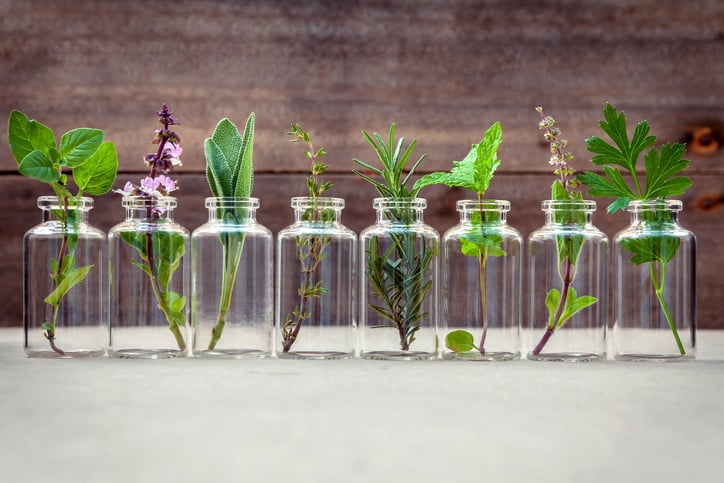Beginner’s Guide to the Benefits of Essential Oils (and how to use them)

More than a decade ago, I discovered what I thought at the time was a crazy use for lavender essential oil. I was on a backpacking trip in the beautiful Big Horn Mountains of Wyoming. In the middle of the mountains, miles from my car, with only the supplies I could carry on my back, I managed to slice my hand wide open. One of my friends pulled out a tiny bottle of lavender essential oil she kept in her first-aid kit and put just one drop onto the cut. While I was initially quite skeptical, I was soon astounded by how quickly my hand felt better. A day later, I had completely forgotten about my wound.
In fact, it worked so well for me that as soon as I got home, I purchased a tiny bottle of lavender essential oil for my personal first-aid kit, and I continue to carry it to this day for cuts, burns, and insect stings and bites.
Granted, this is just a single case, and not everyone may have the same experience, depending on a variety of variables including dramatic differences in the quality and benefits of essential oils. And despite my personal experience—as much of a believer it made me—the science behind lavender’s effects on wounds appears to be mixed.
Yet, essential oils have a long history of use; there’s evidence that essential oils were used in ancient Egypt, China, India, Greece, Rome, and other civilizations over 5,000 years ago. The aromatic extracts were used for beauty, culinary, spiritual, and physical reasons. Of course, you can even find references to the health benefits of essential oils, including frankincense, cinnamon, and myrrh, within the pages of the Bible.
What Are Essential Oils?
According to dictionary.com, essential oils are “any class of volatile oils obtained from plants, possessing the odor and other characteristic properties of the plant, used chiefly in the manufacture of perfumes, flavors, and pharmaceuticals.”
Essential oils are made up mostly of terpenes with smaller levels of alcohols, esters, and other compounds that provide their unique smell, flavor, and benefits. They’re called “essential” because they’re believed to be the very essence of the plant from which they’re derived. Essential oils are very concentrated. For example, it takes about 220 pounds of lavender flowers to make 1 pound of essential oils.
How Are Essential Oils Used?
There are multiple ways to use essential oils. Perhaps the most common is “aromatherapy,” a practice intended to alter one’s mood, cognitive, psychological, or physical well-being. This includes breathing in an essential oil, typically by using a diffuser or by directly inhaling it.
What’s more, when added to a carrier oil (such as almond, coconut, and/or jojoba oils), essential oils can be massaged into the skin, added to bath water, lotion, and much more.
Some essential oils may also be ingested; however, not all oils are safe to ingest, so this method should be approached with strong caution, as you need to ensure the oil you are considering is, in fact, meant to be consumed. If it is, you’re likely to see Supplement Facts listed on the bottle just as you would with your supplements. And if you do choose this method, it is recommended to be used sparingly.
As alluded to above, oils can be applied directly to the skin. Again, however, this should also be done with caution as many oils are very potent and can irritate the skin. More is definitely not better, and when implementing this application, it’s often recommended to dilute the oils using a carrier oil. As with everything, make sure you read the recommended usage for the particular oil and brand you’re considering.
Health Benefits of Essential Oils
The benefits of essential oils are believed to come from their anti-inflammatory, antioxidant, and antimicrobial properties. With a huge variety of essential oils available, you can find far-reaching applications, including home cleaning, insect repellent, relaxation, mood support, skin and beauty applications, and much, much more.
Today, we’ll just hone in on just a few of the most popular essential oils available and their typical uses.
- Peppermint: This oil appears to increase mental alertness and stimulate the mind as it calms and cools the body. It has a fresh, clean scent, and historically, it has been recommended for helping soothe an upset tummy or headache, freshen breath, provide cold and sore throat relief (e.g., open airways), and help relieve tight muscles (when massaged into the skin). It may even help reduce hunger cravings.
- Lavender: It’s no wonder lavender is the most used essential oil. Long recommended as a sleep aid, for which it is indeed effective, it is often recommended to diffuse before bed or even to spray directly on pillows and sheets to promote relaxation. Historically, it has also been used for reducing anxiety and stress, soothing skin for improved complexion, alleviating headaches, and as mentioned above, for helping the body heal from burns and wounds due to its anti-microbial properties.
- Frankincense: Sourced from the resin of Boswellia carterii or sacara trees, this distinctly spicy oil is one of my personal favorites. A little goes a long way, and quality is important, as some listed as “fragrance oils” or “perfumes” are actually synthetic and don’t provide the same benefits. A few drops added to a bath are believed to help relieve stress and anxiety. However, frankincense may be best known for its beneficial effects on the skin. It may help even out complexion and reduce a variety of skin-related issues, including age spots, acne, sagging skin, and wrinkles. An additional benefits of this essential oil is to support the immune system and promote a healthy inflammatory response.
While side effects are rarely reported with essential oils, they can occur. And some oils may interact with prescription medications. So before using, ensure you’re getting the highest quality, pure essential or 100% essential oils from organic sources. And as always, work with your personal healthcare professional to make sure it’s right for you.
There’s a whole world of scents and benefits of essential oils to explore. One of my favorite ways to use oils is to add a couple drops of oil in water with a diffuser as I work. The inspiring scents remind me to breathe deeply and mindfully as I go through my day. And if it helps me think more clearly, energizes me, opens up my lungs, or boosts my mood—that’s an even bigger bonus.






